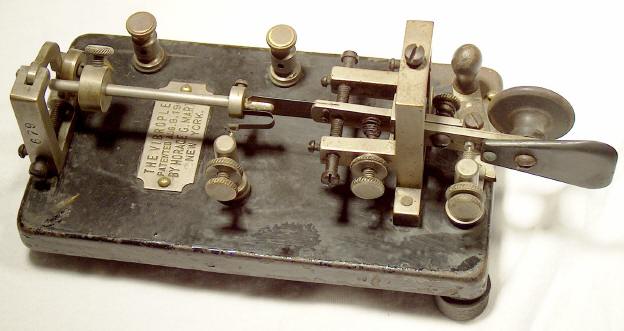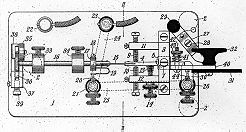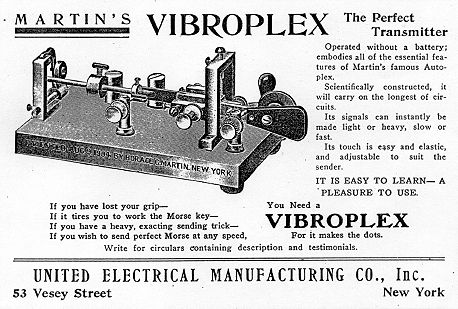J. Casale - W2NI
Horace G. Martin
Part Three : A Vibroplex in Every Telegraph Office
 Some of the first telegraphers to use Horace Martin's Autoplex in the U.S. were called "Bonus
Men". Both Western Union and Postal Telegraph companies had contracts with certain telegraphers who were capable of sending large numbers of messages in the shortest period of time. Bonus Men were paid a premium for each message sent over an agreed upon quota. In turn, the companies provided the telegrapher with the best possible circuit between two cities and kept routine company traffic interruptions to a minimum. This circuit was called the "Bonus Wire". The Autoplex was very attractive to the Bonus Man. He could maintain a high speed for an entire shift and not be subject to the fatigue and strain of using a standard Morse key. The problems were that the companies did not buy the Autoplex; they were owned by the telegraphers. This meant it was necessary for a telegrapher to transport his Autoplex and the required dry cells to each shift. Telegraphers complained to their companies about having to supply their own batteries. They argued that the companies should provide a permanent bonus desk with the ability to connect to a "suitable local arrangement" of the station's batteries. Companies were generally agreeable to comply with this, but they could not agree upon establishing a standard coil resistance for the electro-magnets to be used by Martin and other emerging makers of "magnetic" type keys. Martin's and other inventor's motivation to design a totally mechanical transmitter evolved from these problems.
Some of the first telegraphers to use Horace Martin's Autoplex in the U.S. were called "Bonus
Men". Both Western Union and Postal Telegraph companies had contracts with certain telegraphers who were capable of sending large numbers of messages in the shortest period of time. Bonus Men were paid a premium for each message sent over an agreed upon quota. In turn, the companies provided the telegrapher with the best possible circuit between two cities and kept routine company traffic interruptions to a minimum. This circuit was called the "Bonus Wire". The Autoplex was very attractive to the Bonus Man. He could maintain a high speed for an entire shift and not be subject to the fatigue and strain of using a standard Morse key. The problems were that the companies did not buy the Autoplex; they were owned by the telegraphers. This meant it was necessary for a telegrapher to transport his Autoplex and the required dry cells to each shift. Telegraphers complained to their companies about having to supply their own batteries. They argued that the companies should provide a permanent bonus desk with the ability to connect to a "suitable local arrangement" of the station's batteries. Companies were generally agreeable to comply with this, but they could not agree upon establishing a standard coil resistance for the electro-magnets to be used by Martin and other emerging makers of "magnetic" type keys. Martin's and other inventor's motivation to design a totally mechanical transmitter evolved from these problems.
In May of 1904, Martin filed for his second transmitter patent that included his first attempt at a totally mechanical design by utilizing a vibrating pendulum to produce dots. In this design, a key lever runs parallel to a spring mounted horizontal pendulum, holding it in a position that puts tension on its spring. When the operator moves the key lever to the right, the lever withdraws away from the pendulum allowing it to vibrate. This vibrating pendulum became the basis for the name, "Vibro"- plex. This patent did not go into production, probably for two reasons. Martin appeared to have problems with the vibrating efficiency of this pendulum right from the start. Two of the three design options in this patent still relied upon electro-magnets to help amplify the swing of the pendulum. Also, four months earlier, another telegrapher, William Coffe of Cleveland, filed for a patent that used a similar lever design with an unassisted vertical pendulum.

An early production Martin Vibroplex, serial # 679. |

H.G. Martin Patent # 842154Click here to see the entirepatent drawing. (111K) |
Click here to see a UEM testimonial ad directed
to Railway Telegraph Superintendents. (183K)
Back in New York, UEM was expanding their facilities at 53 Vesey St. The offices and store rooms now occupy the second floor while the manufacturing facilities where Martin was building the Autoplex and Vibroplex, were located up in two large lofts that extend the entire depth of the building. UEM's most popular products at this point were not the Martin keys, but the Uneco and Autoplex dry cells, both 2 ½ X 6" in size, sold for various applications. Martin was also advertising that his manufacturing facilities have been upgraded with new machinery and available for contract and royalty work.

From The Telegraph Age May 1906. |
The Yetman produced uniform characters, but was physically demanding on the sending operator, and its perfect machine-like Morse was considered tiresome for the receiving telegrapher. Also, its individual characters could not be slowed down. The Autoplex and the magnetic Auto-Dot transmitters, if properly adjusted and using good batteries, produced the "most reliable signals". The all-mechanical transmitters, including the Auto-Dot, Mecograph and Vibroplex, were all considered capable of producing favorable signals but felt only the Bonus Men and first class press operators were the only ones that were operating them properly. The average operator was criticized for not knowing how adjust them correctly and the cause of many errors on Postal's system.
Martin dealt with the problem of educating and reaching the average telegrapher on several fronts. He became what is known in the Ham Radio ranks today as an "Elmer" (mentor) to many telegraphers. He personally helped telegraphers who were making the transition from a straight key to a Vibroplex. He solicited the aid of some of his telegrapher friends, many of them only in their twenties, to be agents and give demonstrations in various U.S. cities. To encourage home practice, Martin offered for one dollar, his small "Gem" key and sounder set with the idea of using its sounder as a receiver with the Vibroplex. Also, in these early months, he was known to give away many Vibroplexes in order to get them introduced at important offices.
Martin furthered his efforts to make his Vibroplex the first transmitter owned by the average telegrapher by entering into a price war with his two major competitors : Mecograph and Auto-Dot. In the spring of 1906, the Martin Vibroplex was being sold for $12.00, the Auto-Dot for $10.75, and the Mecograph model # 3 for $10.00. By mid-summer, Martin lowered his price to $7.50, but Mecograph countered this by lowering the price of all their models to $7.50 including their newest model #4. Around the time of the Postal Telegraph evaluations, Martin was most likely tired of dealing with the Mecograph Co., and lowered the price of his Vibroplex even further to $5.00. It is hard to imagine he was operating in the black at this price.
Click here to see the UEM ad promoting
the Vibroplex for $5.00. (140K)
Throughout his career, Martin was never preoccupied with making a profit, but rather head strong in achieving a goal. In 1906, he was clearly "determined to place in every telegraph office in the United States and Canada at least one Vibroplex", a goal that no one would dispute that he eventually achieved. Martin has never really received the recognition and credit he deserves in several categories, but especially for his efforts during these early years and the impact he had on the career of the average telegrapher. During the World War II era, it was stated that wherever Morse was spoken in the U.S. and wherever Americans have gone to speed up Morse transmissions in the world, that most likely a Martin Vibroplex was being used. This seems a fitting legacy for the quiet and very modest telegrapher from Georgia.......
Return to the Horace G. Martin home page
Horace Martin for their help with my research.